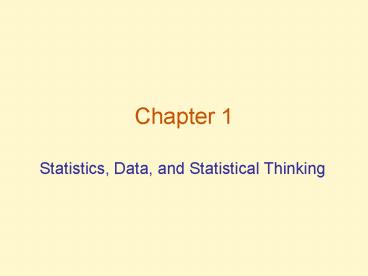Statistics, Data, and Statistical Thinking PowerPoint PPT Presentation
1 / 17
Title: Statistics, Data, and Statistical Thinking
1
Chapter 1
- Statistics, Data, and Statistical Thinking
2
The Science of Statistics
- Statistics the science of data
- Collection
- Evaluation (classification, summary, organization
and analysis) - Interpretation (drawing conclusions based on the
data.)
3
Types of Statistical Applications
- Descriptive Statistics summarize or describe
the important characteristics of a known set of
population data - Inferential Statistics use sample data to make
inferences (or generalizations) about a population
4
Fundamental Elements of Statistics
- Experimental Unit object of interest
- example graduating senior
- Population the set of units we are interested
in learning about - example all 1450 graduating seniors at State
U - Variable characteristic of an individual
population unit - example age at graduation
5
Fundamental Elements of Statistics
- Sample subset of population
- example 100 graduating seniors at State U
- Statistical Inference generalization about a
population based on sample data - example The average age at graduation is 21.9
(based on sample of 100) - Measure of reliability statement about the
uncertainty associated with an inference
6
Types of Data
- Quantitative Data
- measured on a naturally occurring scale
- equal intervals along scale (allows for
meaningful mathematical calculations) - data with absolute zero (zero means no value) is
ratio data (bank balance, grade) - Data with relative zero (zero has value) is
interval data (temperature)
7
Types of Data
- Qualitative Data
- measured by classification only
- Non-numerical in nature
- Meaningfully ordered categories identify ordinal
data (best to worst ranking, age categories) - Categories without a meaningful order identify
nominal data (political affiliation, industry
classification, ethnic/cultural groups)
8
Fundamental Elements of Statistics
- Elements of Descriptive Statistical Problems
- population/sample of interest
- investigative variables
- numerical summary tools (charts, graphs, tables)
- pattern identification in data
9
Fundamental Elements of Statistics
- Elements of Inferential Statistical Problems
- population of interest
- investigative variables
- sample taken from population
- inference about population based on sample data
- Reliability measure for the inference
10
Types of Data
- Different statistical techniques used for
quantitative and qualitative data - Qualitative and Quantitative data can be used
together in some techniques - Quantitative data can be transformed into
Qualitative data through category creation - Qualitative data cannot be meaningfully
transformed into Quantitative data
11
Collecting Data
- Data Sources
- Published source books, journals, abstracts
- Primary vs. secondary
- Designed Experiment
- Often used for gathering information about an
intervention - Survey
- Data gathered through questions from a sample of
people - Observational Study
- Data gathered through observation, no interaction
with units
12
Collecting Data
- Sampling
- Sampling is necessary if inferential statistics
are to be used - Samples need to be representative
- Reflect population of interest
- Random Sampling
- Most common sampling method to ensure sample is
representative - Ensures that each subset of fixed size is equally
likely to be selected
13
The Role of Statistics in Critical Thinking
- Statistical literacy is necessary today to make
informed decisions both at work and at home - Requires statistical thinking to critically
assess data and the inferences drawn from it - Statistical thinking assists you in identifying
research resulting from unethical statistical
practices
14
The Role of Statistics in Critical Thinking
- Common Sources of Error in Survey Data
- Selection bias exclusion of a subset of the
population of interest prior to sampling - Nonresponse bias introduced when responses are
not gotten from all sample members - Measurement error inaccuracy in recorded data.
Can be due to survey design, interviewer impact,
or a transcription error
15
Summary
- 2 types of statistical applications in business
Descriptive and Inferential - 6 fundamental elements of statistics
- population
- experimental units
- variable
- sample
- inference
- measure of reliability
16
Summary
- 2 types of data Quantitative and Qualitative
- 4 Data collection methods
- published source
- designed experiment
- survey
- observation
17
Summary
- Sources of Error in Survey Data
- selection bias
- non-response bias
- measurement error

